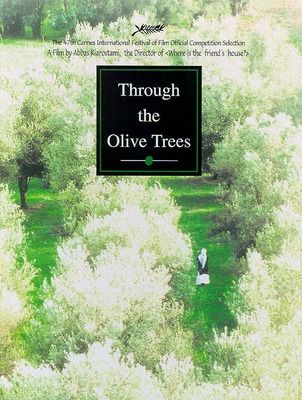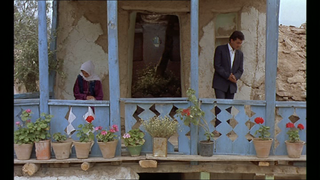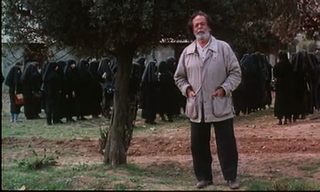
Through the Olive Trees
1994
Director: Abbas Kiarostami
Starring: Mohamad Ali Keshavarz, Hossein Rezai, Zarifeh Shiva, Tahereh Ladanian
Apparently I’m on a bit of an Iranian film tear. I don’t care, I think they’re pretty damn awesome.
Kiarostami is rapidly becoming a new fascination with me. Through the Olive Trees is the second film I’ve seen by him; the first, Taste of Cherry, I saw about a month ago and found it a fascinating contemplation on life and death in the modern world. Through the Olive Trees is not as profound as Taste of Cherry, more resembling a comedy than a philosophical drama, but it still has a significant resonance.
There has been an earthquake in Iran. A filmmaker (Keshavarz, an obvious stand-in for Kiarostami himself) is shooting a film about how lives have been affected by the tragedy, and he casts locals who have suffered themselves. Problems arise when the young man he casts as the lead, Hossein (Rezai), admits that he is in love with the young woman cast as Hossein’s wife, Tahereh (Ladanian). Thing is, Tahereh’s grandmother is dead set against the match and Tahereh herself won’t even speak to Hossein – not even on set, speaking the lines. Ah, young love – ever the enemy of a filmmaker’s vision.

Although the story of lovestruck Hossein pursuing Tahereh is the central narrative of the film, there is much more going on in Through the Olive Trees than just that. It’s also very much a movie about how movies are made. One of the first scenes is of Mrs. Shiva (Zarifeh Shiva), who appears to be the film’s producer, gathering flower pots from local families because the scene they are shooting today needs flowers on the balcony. Hossein is not only the actor, but also a bit of a grunt on the set; in between shots, he serves the crew tea and cleans up. The cast and crew have to sleep in tents close to the shooting location, and there are early morning wake up calls. An actor has to be replaced because he can’t say his lines correctly. The shooting crew argues incessantly about who gets to take the truck and who has to wait for the minibus. Honestly, there is such humor and love and reverence with respect to the shooting of the film within a film that I kept on thinking this was the Iranian version of Truffaut’s Day for Night.
Kiarostami plays freely with the fourth wall, erecting it then tearing it down, sometimes seconds apart. Mohamad Ali Keshavarz opens the film by introducing himself to the audience and explaining that he will be playing the role of the director, but at some point in the following minutes, he has started acting. All other roles are filled by nonprofessionals, and I can’t help but get the feeling that their personal experience with the earthquake (which actually happened) and their lives in Iran closely resemble those of the “characters” they are portraying in both Kiarostami’s film and the film-within-a-film. Art imitates art imitates life? Oh, it’s a heady brew.

As with Taste of Cherry, most of the dialogue in the film is said in cars. People are transported from their homes to the set and back again, giving ample time for them to air their feelings, thoughts, and musings aloud. Kiarostami clearly feels the power of conversation in automobiles. He knows that when you’re in a car and you’re not forced to maintain eye contact with the other person, it can sometimes be easier to say the most intimate secrets of your heart than if you were sitting across a table from them. Truly, think back to some car trips you’ve taken, and reflect on the conversations you’ve had. I have no doubt that you’ve gotten into some deep stuff, and really, most of the reason was your location. Kiarostami gets that. Almost all the significant conversations of the film – on love, on Iran, on the earthquake – take place in a car.
The Iran that Kiarostami photographs in Through the Olive Trees is a wholly different country than that which he showed in Taste of Cherry. This is a much more pastoral Iran. It is green and lush, filled with rolling hills and orchards and streams. I have never seen this Iran before, almost Italianate in its romanticism. Kiarostami takes full advantage of this and shoots the film entirely in exteriors. There is not a single interior shot in the film (unless you count the interior of car, which was actually driving on the roads); this is clearly a reference to all of those transplanted by the earthquake and forced to live in tents rather than under roofs.
One of the things I loved the most about Taste of Cherry was its ambiguous ending. Through the Olive Trees, likewise, has a less than certain finale. I believe Kiarostami suggests pretty strongly what happens, but he keeps his audience at a distance – literally - so that we cannot be completely certain. I know what I like to think happened, but I also know that Kiarostami let me reach that decision on my own without forcing it on me. Furthermore, I realize that the ending that I imagine is reflective of my own personal hopes, dreams, and philosophies; someone else with a different mindset might interpret the ending in a different manner. And dammit, I love it when a filmmaker does that.
I really enjoyed Through the Olive Trees, but I recommend it with caution. There’s a lot of talking in the movie. A lot. If the thought of talking head scene after talking head scene without any significant action sounds horrific, then this is not the film for you. But if it sounds like an interesting film, then I wish you luck seeing it. See, apparently, Miramax owns the rights to the film and is being all douche-y about releasing the film on VHS or DVD, in that they won’t. I was fortunate enough to see a screening of Through the Olive Trees on the big screen. It’s really too bad that it’s not available for home viewing. It was a very charming little film.
I am now very much looking forward to seeing additional Kiarostami films. As I said, he is quickly starting to fascinate me.
Arbitrary Rating: 8/10
adidas nmd uk
ReplyDeleteskechers shoes
air jordan retro
ralph lauren online
yeezy shoes
michael kors uk
ralph lauren online,cheap ralph lauren
adidas tubular runner
adidas tubular sale
hermes belt for sale